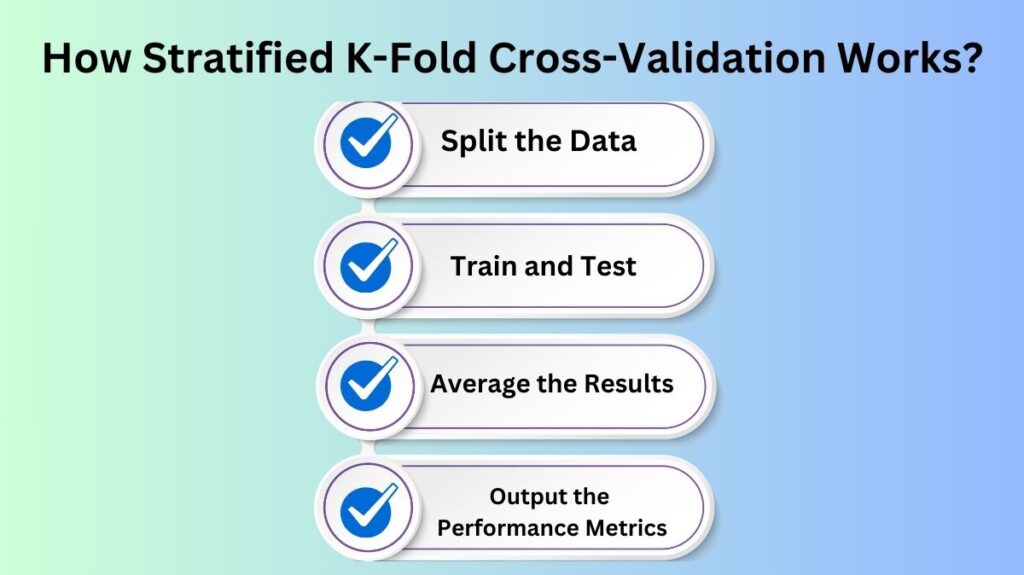The goal of machine learning is to make models that can be used with new data. We need to fully test the model’s performance before we put it into production. Stratified K Fold Cross Validation (SKCV) is a common cross-validation method that is used when datasets are not fair.
Stratified K-fold Cross-validation is more advanced than conventional K-Fold because it preserves the target class distribution in each fold. This strategy prevents underrepresentation of classes in training and validation sets in imbalanced datasets.
This article discusses Stratified K-Fold Cross-Validation, its importance, how it works, and practical cases.
What is Cross-Validation?
Understand cross-validation before learning about Stratified K-Fold. By splitting the dataset into different sections, cross-validation evaluates machine learning models. To determine its accuracy, the model is trained on some subsets and tested on others. Since it averages results from numerous training and testing cycles, cross-validation is most useful for estimating model performance.
This type of cross-validation divides the dataset into ‘K’ equally sized (or nearly equal) folds. Each fold is tested once and trained, K-1 times, for the model. After K runs, the model’s performance is averaged.
K-Fold Cross-Validation may not accurately assess model performance in imbalanced datasets because the target class distribution in each fold may not be representative of the dataset.
What is Stratified K Fold Cross Validation?
Extensions of K-Fold Cross-Validation that account for target class distribution are called stratified. Traditional K-Fold Cross-Validation randomly chops data into K subsets. When working with imbalanced datasets, this strategy can cause uneven fold class distributions. But Stratified K Fold Cross Validation assures that each fold has the same proportion of each class as the original dataset.
Specially for categorization jobs when one class may outnumber others. If a dataset has 90% of one class and 10% of another, random splits may result in folds with few or no minority class instances. Since only a subset of classes may be trained or evaluated, model evaluation would be unreliable.
To fix this, Stratified K-Fold Cross-Validation balances the folds according to class distribution. The folds will have representative samples of each class, like the dataset.
Why Use Stratified K Fold Cross Validation?
- Improved Model Evaluation: Working with imbalanced datasets might lead to deceptive K-Fold Cross-Validation results. Because each fold has a similar class distribution, Stratified K-Fold Cross-Validation provides a more accurate model performance rating.
- Reliable Estimation of Model Performance: For classification problems, especially those with imbalanced classes, it’s important to estimate model performance on both majority and minority classes. Train and test the model on balanced subsets with Stratified K-Fold Cross-Validation for more accurate estimation.
- Reduces Bias: Without stratification, the model may be trained on data skewed toward the majority class, overfitting and not performing well on the minority class. By balancing class representation across folds, stratified K-Fold reduces this bias.
- Better Hyperparameter Tuning: Stratified K-Fold Cross-Validation tests hyperparameter settings across numerous balanced folds to optimize performance for both classes.
How Stratified K Fold Cross Validation Works?
The steps of Stratified K-Fold Cross-Validation are:

- Split the Data: The dataset is split into K equal-sized folds. Unlike classic K-Fold, the stratified technique optimises target class distribution in each fold to match the complete dataset.
- Train and Test: The model is tested on the remaining fold after training on K-1 folds. This is repeated K times, using each fold as a validation set.
- Average the Results: The model’s performance is estimated by averaging the performance metrics (accuracy, precision, recall, F1 score) after K iterations.
- Output the Performance Metrics: Assuming a balanced representation of each class, Stratified K-Fold Cross-Validation produces performance measures that show how well the model will perform on unseen data.
Where Stratified K Fold Cross Validation is Useful?
- Imbalanced Classification Problems: Stratified K-Fold Cross-Validation is needed when class instances contrast greatly (e.g., fraud detection, medical diagnosis). Making sure the minority class is represented in each fold improves model performance measures.
- Small Datasets: Stratified K-Fold Cross-Validation ensures that every fold gets a representative sample of all classes, making the most of limited data for training and validation.
- Sensitive Applications: Stratified K-Fold helps evaluate the model’s performance on both the majority and minority classes in sensitive applications like healthcare, fraud detection, and unusual event prediction.
- Tuning Complex Models: Complex models like deep learning networks must be validated to match real-world performance. A suitable class distribution in each fold makes Stratified K-Fold estimate credible.
Advantages of Stratified K Fold Cross Validation
- Preserves Class Distribution: Stratified K Fold Cross Validation helps assess model performance more accurately by ensuring that each fold match the class distribution.
- Better for Imbalanced Datasets: This strategy ensures that the model is tested on both classes, making it ideal for imbalanced datasets.
- Reduces Bias: Stratification limits training and testing on folds that do not represent classes, enhancing model generalization.
Disadvantages of Stratified K Fold Cross Validation
- Complexity: Stratified K-Fold Cross-Validation involves numerous training and validation cycles, making it computationally expensive for large datasets.
- Not Always Applicable to Regression: Classification tasks are excellent for Stratified K-Fold, whereas regression problems that predict continuous values are not.
- Overfitting Risk: Overall, Stratified K-Fold decreases bias, although it can still overfit, especially with short datasets or complex models.
Conclusion
Machine learners benefit from stratified K Fold Cross Validation, especially with skewed datasets. This strategy reduces bias and overfitting by preserving the class distribution in each fold to estimate model performance more accurately. When majority and minority classes are crucial, Stratified K-Fold Cross-Validation ensures that the evaluation procedure is as realistic of real-world data as possible.
In conclusion, SKCV can improve model evaluation for classification problems, especially those with imbalanced classes.
